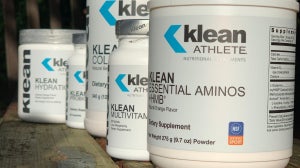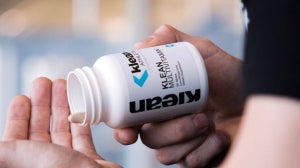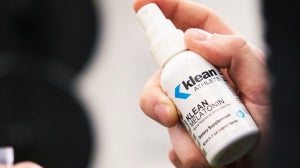

By: Heidi Harris, RD-N, CD-N, LD-N
What You’ll Learn: In this blog, we will identify what Threshold Training is, discuss the different energy zones and which nutrients help fuel your workout in each zone.
Before We Begin:
Hello! My name is Heidi. I’m a Registered Dietitian, certified strength training and conditioning coach and certified SpinPower® instructor. Today, I want to talk with you about a common theme in both strength training and endurance exercises like cycling, running and swimming: Threshold Training. We’ll focus on nutrients to help fuel you as an athlete to your next level of optimal performance.‡
What is Threshold Training?
You may have heard of threshold training if you’ve ever researched strategies on preparing for a long-distance run, bike ride or maybe even a 500 meter freestyle swim. Threshold training is all about making small, gradual gains that lead to great outcomes and individualized improvements to help you accomplish your training goals.Threshold training is a type of individualized training program that utilizes five different training zones and a personalized threshold to help athletes yield greater athletic progress and performance without running the risk of over-exercising.1

In simpler terms, a threshold is some form of exercise intensity where your physiology shows a marked change.2 A good way to visualize threshold training is by first imagining you’re running a 5k at your usual jogging pace. You’re running, your breathing is steady and measured, you’re exerting energy and have a steady stream of sweat, but it’s feeling manageable and controlled. Now, imagine you are running that same 5k but this time, at an all-out sprint. Your breathing is heavy, your heart is racing. That stitch in your side kicked in somewhere around the 1.5 mile marker.
The distance didn’t change.
The person running the 5k didn’t change.
You’ve run a 5k before.
You’ve even practiced sprints before.
So… what changed?
This marked physiological change and increased effort output by the athlete is part of the zone training within the exercise methodology: threshold training.1 To make it concise, the level of effort required to run a 5k at an all-out sprint requires a certain level of energy output and a certain amount of power provided by the athlete. Once the athlete can no longer continue at this pace and can no longer maintain this level of effort or energy output, they need to break or back off their pace and decrease their effort output– this is the moment where they’ve reached their personal threshold.3
Once this threshold has been determined, athletes and trainers can work together to create personalized threshold trainings to help improve their effort and overall athletic performance without overdoing it. You’ve probably heard of threshold training before, but maybe in a different way. In running terms, it’s often referred to as your T-pace and in cycling it’s often referred to as PST (or your personal spinning threshold).2,3 Either way, the ability to nutritionally fuel for your threshold training may help optimize your physical performance. ‡
Threshold Training: The Zones
To effectively prepare for threshold training, we need to first understand the different energy zones that occur before, during and after you’ve reached your personal threshold. Threshold training consists of 5 different zones. Zone 1 through the first half of Zone 3 include up to 85% of your maximum heart rate and falls within the aerobic energy zone. This zone utilizes fat for fuel and requires oxygen to generate ATP (adenosine-triphosphate).3
Zone 3 is where your personal threshold lives. This is because there is a change that happens during Zone 3 of training. Each athlete is different (which is why we call it our personal threshold), but in general Zone 3, our bodies transition from oxygen as a component of generating ATP to the anaerobic phase of energy training, or not using oxygen to create the energy currency, ATP. ATP acts as a form of energy currency in the body.4 When this change occurs, your personal threshold has been met.
In the second half of Zone 3 to Zone 4, 105% to 120% of your maximum heart rate, is part of the anaerobic energy zone which means that the body stops using fat for fuel and reliance on oxygen to generate ATP via mitochondrial pathways and transitions to using glycogen, the storage form of glucose, and generates ATP without relying on oxygen.5 There’s more science to that, but for the purpose of focusing on threshold training, we’ll leave it at that. To know when you’ve met the Zone 4 of threshold training, look for signs of sucking down air. Breathing becomes difficult and challenging during this zone. You are sweating and maintaining a pace that you can’t handle for long periods of time.
Zone 5 is reserved for those quick bursts of intense energy output. This zone remains within the anaerobic zone and includes 120% heart rate to your maximum heart rate and the metabolite Creatine within the muscles is the primary resource to generate ATP.3
Threshold Training: Fueling the Aerobic Zones:
Considering Zone 1 through the first half of Zone 3 focuses on the aerobic energy zone using fat for fuel, why don’t we focus on some nutrients to help support us in this aerobic phase of threshold training?5‡
Remember when drinking beet juice was a major craze before a long run or a major endurance exercise program? Okay, I know that’s kind of a throwback and there’s more to the story than just beet juice, but let’s not throw beets entirely out the window. Beetroots are an excellent source of nitrites.
Our Klean Pre-Workout provides 140mg of TruBeet® — all-natural nitrates derived from beetroot.
Some studies indicate that athletes who supplemented with beetroot extract increased time to exhaustion during high-intensity interval training which led to improved stamina and endurance and reduced oxygen consumption during submaximal exercise.6,7,8‡
Nitrate supplementation has been clinically shown to support cardiovascular function, possibly by sparing ATP and enhancing muscle kinetics.7,8‡
With the additional support for cardiovascular function and the support for reduced oxygen consumption, nitrates may support performance during your next aerobic threshold training session.
Plus, since threshold training is usually done for longer durations, it’s likely you’re going to sweat. When you sweat, you not only may decrease your hydration retention, but also may start to deplete some of your electrolyte stores.9 Ever seen a marathon runner take a glucose or electrolyte tab in the middle of their race? Or maybe you’ve seen the volunteers on the side of the road race handing out water? There’s a reason for that.
Electrolytes help to maintain a normal balance of fluids within the body.‡
Electrolytes assist in maintaining fluid and pressure balance between the inside and outside of cells and help to support the systems that regulate blood flow.10‡
Electrolytes are also critical to nerve and muscle function. For example, muscle contraction is dependent upon the presence of calcium, sodium and potassium.9‡
Electrolytes lost during exercise, particularly workouts that are long lasting (like long aerobic energy runs or cycling) or strenuous, can lead to fatigue, dehydration and muscle cramps.10‡
Klean Electrolytes supplies sodium, potassium, chloride, calcium and magnesium to help replenish electrolytes and retain hydration. This is just one way you can help supplement your personalized threshold workout for your optimal physical performance. Now, let’s take a little closer look at these zones.
Threshold Training: Fueling Your Endurance Zone:
We’ve talked about how to know which zone you’re in, but Zone 3 can be tricky because this is where your personal threshold lies… how do you know? This is where you start asking yourself, “How long can I last?” or, “How much more can I endure?” or maybe even the thought has occurred to you during a particularly strenuous distance workout, “Just one more mile at this pace… I can do it!” If those thoughts have ever crossed your mind, then let me be the first to welcome you to your personal threshold.
At this point, your body has a decision to make. Will you drop your pace and revert back to your jogging or cool down pace and let your heart rate slow? Or, will you keep it up and move into the anaerobic energy zone where your body starts to burn glycogen for fuel independent from oxygen.5 Decisions, decisions… In order to get the most out of your threshold training there are a few key things you should know about the nutrients to help support your optimal personal threshold. ‡
The key here: ATP production. If you chose to continue with anaerobic training, well you’re well on your way to Zone 4, but before we get there, we need to keep up our athletic endurance. Let’s figure out some key nutrients that help support ATP synthesis and cardiac energy metabolism during this endurance phase.11‡
D-ribose is used to make ATP as it’s naturally part of ATP’s structure.12
Supplemental D-ribose may bypass the traditional pathway of generating ATP via purine metabolism, which occurs in the mitochondria. This process is more efficient, as it enables cells to efficiently reuse ATP metabolites to form new ATP molecules.12
D-ribose plays a critical role in energy metabolism by restoring and enhancing ATP concentrations. Clinical studies have shown that supplementation with D-ribose promoted the support of blood flow, recovery rate of ATP synthesis and cardiac energy metabolism.11,12‡
Supplemental D-ribose has been shown to support tissue energy repletion and improve recovery and performance in humans.13‡
The involvement of ribose in mitochondrial energy production may also indicate a supportive role of D-ribose in overall mitochondrial function and quality.14
If you’re looking to supplement with some D-ribose for your next personalized threshold training, check out our Klean Endurance provides 1.67 grams of D-ribose in a convenient, tablet form. Now, let’s dive deeper into the anaerobic phase of Zone 4 training.
Threshold Training: Nutrient to Aid Anaerobic Training:
The second half of Zone 3 and all of Zone 4 utilize anaerobic training. We talked earlier about how glucose is the main way your body fuels itself during aerobic training but to keep improving your personal threshold here are some key tips and nutrients to consider in the anaerobic phase of threshold training.
This stage of exercise has most frequently been associated with strength-based training. You may have heard of it during your high-intensity interval training (HIIT), circuit training and other forms of strength training. But did you know? Appropriate threshold training uses Zone 3 and Zone 4 to help improve your personal threshold.15‡
Some trainers and athletes will use their personal threshold, or T-pace or PST (cycling) as a baseline and then pick up their pace to provide an effort output greater than the effort required to maintain their threshold. Going above their personal threshold helps increase their physical performance without over-exercising and may help improve their threshold capacity for next time.‡
Branched-chain amino acids (BCAA) promotes an athlete’s recovery and muscle tissue repair following strength competitions such as body building and powerlifting, and other anaerobic and aerobic exercises.16‡
There are 3 BCAAs: Leucine, isoleucine and valine. They work together to support muscle protein synthesis, thereby contributing to strength and muscle gains that result from consistent training.17‡
In a study, male athletes who supplemented with BCAAs for eight consecutive days showed enhanced endurance exercise capacity.18‡
Within the cell, ATP is the major source of cellular energy. Extracellular ATP and its metabolites support a variety of biological processes, including cardiac function, neurotransmission, liver glycogen metabolism, muscle contraction and blood flow.19‡
Peak ATP® is an ATP supplement that provides a direct source of energy to the muscle and improves post-exercise blood flow and recovery. During exercise, ATP is released from human red blood cells when oxygen is low in a working muscle region. As a result, vasodilation occurs and increases blood flow to the muscle. Increased blood flow assists in the delivery of oxygen and nutrients to the cell and supports tissues in the body. Human and animal studies show ATP supplementation increases blood flow following exercise.20‡
Peak ATP® appears to work by buffering fatigue during exercise and increasing skeletal muscle blood flow, ultimately enhancing muscle oxygen recovery.‡
Not to mention, our Klean BCAA Powder + ATP provides 400mg of Peak ATP® which is the only oral form of ATP shown to improve body composition and athletic performance. Peak ATP® has been studied and the results demonstrate 400mg of oral ATP supplementation for 12 weeks reduced protein breakdown and significantly increased muscle mass, strength and power.21 Muscle mass, strength and power – all are critical elements of effective threshold training.‡
Threshold Training: Zone 5 & Creatine:
Zone 5 – the final zone of threshold training – is also part of the anaerobic energy zone. This time, fueling your power output with the metabolite creatine. Remember: Creatine is meant to be used to fuel short bouts of high energy output.22 Zone 5 is not meant to last for long durations, but rather short periods of time.
Creatine is an energy carrier that is naturally present in your muscles, brain and other organs. In muscles, creatine, in the form of phosphorylcreatine, acts as a reserve of high-energy phosphate to provide energy during anaerobic exercise by regenerating ADP to ATP.23‡
By increasing the rate of creatine phosphorylation, ammonia and lactate levels in the blood are lowered resulting in faster recovery from exercise.24‡
Creatine also promotes growth factor signaling and glycogen storage to support gains in muscle strength, size and other adaptive responses to training.24‡
Creatine may increase strength, fat free mass and muscle morphology with concurrent heavy resistance training more than resistance training alone.25‡
One serving of our Klean Creatine provides 5mg of creatine monohydrate, the form and dose that’s often used in studies, to support muscle performance in high-intensity or even dynamic movements.26
Plan Your Workout:
I can’t stress this enough. If you’re looking to really expand upon your personal threshold training, I need you to focus on the following three key elements:
Determine your threshold. Find that breaking point – that right there, is your personal threshold, usually occurring around 100% of your heart-rate.3
Plan your workout. Are you doing an endurance run in the aerobic zone? Or are you warming up with a personal threshold jog and then adding in sprints in Zone 4?
Fuel for the energy zone you’re working in.
You’ve got access to nutrients to help optimize your physical performance. What’re you waiting for? Check our Klean Athlete today!‡
References:
Threshold Heart Rate Training Methodology. (n.d.). Heart Zones. Retrieved January 10, 2023, from https://www.heartzones.com/heart-rate-training/threshold/
Costill, D.L. (1986). Inside Running: Basics of Sports Physiology. Benchmark Press: Indinapolis, USA.
Getting Started with Personal Spinning® Threshold (PST). (n.d.). Spinning®. Retrieved January 10, 2023, from https://spinning.com/spinlife/getting-started-with-personal-spinning-thresholdpst/
Zhang ZY, Fan ZK, Cao Y, et. Al. Neurosci Lett. 2015 Sep 14;604:18-23.
Chamari, K., & Padulo, J. (2015). “Aerobic” and “Anaerobic” terms used in exercise physiology: a critical terminology reflection. Sports
Medicine – Open, 1(1). https://doi.org/10.1186/s40798-015-0012-1
Nyakayiru J, Jonvik KL, Trommelen J, et al.. Nutrients. 2017 Mar 22;9(3).
Eggebeen J, Kim-Shapiro DB, Haykowsky M, et al. JACC Heart Fail. 2016 Jun;4(6):428-37
Bailey SJ, Fulford J, Vanhatalo A, et al. J Appl Physiol 2010;109:135-148.
Convertino VA, et al. Med Sci Sports Exerc. 1996 Jan;28(1):i-vii. Review.
Gupta N, Jani KK, Gupta N. Indian J Med Sci. 2011 Mar;65(3):121-32. doi: 10.4103/0019-5359.104787. Review. [Electrolytes].
Pauly DF, Pepine CJ. J Cardiovasc Pharmacol Therapeut. 2000;5(4): 249-258
Wagner S, Herrick J, Shecterle LM, St Cyr JA. Prog Cardiovasc Nurs. 2009 Jun;24(2):59-60.
Seifert JG, Brumet A, St Cyr JA. J Int Soc Sports Nutr. 2017 Dec 20;14:47
Martin-Fernandez B, Gredilla R. Age (Dordr) 2016;38:225–238
Buchheit M, Laursen PB. Sports Med. 2013 Oct;43(10):927-54.
MacLean DA, Graham TE, Saltin B. Am J Physiol. 1994 Dec;267(6 Pt 1):E1010-22.
Dimou A, Tsimihodimos V, Bairaktari E. Int J Mol Sci. 2022 Apr 5;23(7):4022.
Matsumoto K, Koba T, Hamada K, et al. J Nutr Sci Vitaminol (Tokyo). 2009 Feb;55(1):52-8.
Jäger et al. Journal of the International Society of Sports Nutrition 2014, 11:28
Farias M 3rd, Gorman MW, Savage MV, Feigl EO. Am J Physiol Heart Circ Physiol. 2005 Apr;288(4):H1586-90.
Wilson, et al. Nutrition & Metabolism 2013, 10:57. (2021, March 10). What Do Athletes Need to Know About Creatine? | USADA.- https://www.usada.org/spirit-of-sport/education/athletes-need-know-creatine/
McCall W, Persky AM. Subcell Biochem. 2007;46:261-73.
Izquierdo M1, Ibañez J, González-Badillo JJ, Gorostiaga EM. Med Sci Sports Exerc. 2002 Feb;34(2):332-43
Cooper R, Naclerio F, Allgrove J, Jimenez A. J Int Soc Sports Nutr. 2012; 9: 33
Williams MH, Branch JD. J Am Coll Nutr. 1998 Jun;17(3):216-34.








